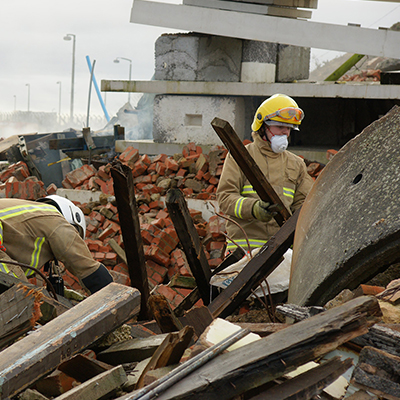No specific manner of death or number of fatalities defines a mass fatality incident. According to the National Association of Medical Examiners, a mass fatality incident is defined as “any incident resulting in more decedents to be recovered than can be managed in the local Medical Examiner/Coroner jurisdiction.” This broad definition can cover anything from a mass shooting or a weather event like Hurricane Katrina to the ongoing COVID-19 pandemic.
Keep in mind that mass fatality and mass casualty are two different things. But what is the difference between a mass fatality incident and a mass casualty incident?
A mass casualty incident puts pressure on medical transportation and trauma care facilities due to the large number of injured individuals requiring treatment. A mass fatality incident, by comparison, is purely focused on the deceased and can be the result of a variety of causes; examples include natural disasters like earthquakes and floods, transportation accidents, and mass homicides/terrorist attacks.
A mass fatality incident increases pressure on many facets of the jurisdiction in which the incident takes place: the first responders conducting the search and recovery efforts, the medical system identifying victims and assigning causes of death, and the legal system issuing death certificates. We’ll be looking at the challenges that first responders face during a mass fatality incident and how these challenges can be met.
Obstacles with Mass Fatality Logistics
Preparedness is key to a proper mass fatality response, but there are many challenges in overcoming a mass fatality incident.
Small and medium sized jurisdictions may not have the resources for emergency preparedness or the experience in mass fatality management (especially when compared to a place like New York City). Other problems, however, are common to jurisdictions no matter their area or population size.
Lack of Preparedness
A problem often found in (but not strictly limited to) smaller, more rural jurisdictions is the myth that “it can’t happen here.” This mode of thinking has started to change in recent years but is still prevalent. Unless there is an airport, major highways, or rail lines in a given jurisdiction, a mass fatality incident is still often seen as a low probability.
Natural disasters, however, can strike anywhere, leading to mass fatality incidents like the tornado that hit Joplin, Missouri in 2011 and caused more than 160 deaths. There is almost nowhere in the United States that is completely free of the risk of some sort of weather or geological event with the potential for mass fatalities.
Poor Emergency Management
Unfortunately, some jurisdictions tend to resist reaching out for assistance when it becomes necessary. Local authorities need to be trained to understand the scope of a mass fatality incident and be ready to call on whatever assistance that may be needed in order to get the situation resolved professionally and in an acceptable amount of time.
If the site requires specialists of any kind, local authorities should be aware of exactly who to contact for those resources. Those same authorities must also know when to reject help. Large scale disasters can bring in unwanted assistance from responders who elect to dispatch themselves to the site, especially if the incident is large and receives high exposure through the media. Local mass fatality incident plans should have a policy in place concerning the matter of unrequested or unneeded responders.
Mass fatality incidents often involve a multitude of local, state, and (possibly) federal agencies that need to be at the site. These agencies must perform their defined roles without interfering in each other’s work, but at the same time cooperate and engage in mutual aid. Working together in close quarters for weeks, or even months depending on the extent of the incident, may be necessary and needs to be considered.
Factors Affecting Recovery Time for Human Remains
Human remains can take an extended amount of time to recover, especially in the event of a disaster like a bombing or building collapse. The bodies may have been exposed to radiological, biological, or other hazardous materials and could require decontamination. Additionally, victim identification may have to rely on forensic dental imaging or DNA samples.
By comparison, a mass shooting can leave a huge crime scene that has to be examined and processed by authorities. Throughout that assessment period, the system of agencies in place will need to deal with planning and administration issues while also handling the media and attending to grieving families.
Attending to families and next of kin is yet another challenge that results from a mass fatality incident. Authorities must secure space for family and victim outreach.
Family members of the victim should have a place to receive official information that is out of the public eye while also having access to mental health or grief counseling, if needed. If the incident is a plane crash or some kind of event involving individuals with families that live out of state (or even out of the country), lodging arrangements need to be considered.
Victims’ families will have questions about their loved ones’ whereabouts and health status. They need to be informed of how remains will be identified, how long identification will take, and how they will be informed when their family member has been positively identified. Plans must also include who is ultimately responsible for releasing this information so that there is no confusion and no families are overlooked. If the incident is severe and victims need to be identified through forensic means, the process can take days, weeks, or even longer.
Strategies in Emergency Management
These common obstacles with mass fatality incident management bring to light the importance of up-to-date training and having a mass fatality plan in place that all first responders are prepared to execute.
Luckily, active shooter drills are becoming commonplace in all levels of society, like schools and government buildings. For decades, local law enforcement and fire departments have undergone training covering a wide range of disaster scenarios. But, now it’s become increasingly important to regularly include training on mass fatality incidents. Training should not just include role plays of the incident itself, but also should involve everything that follows: injured persons being transported from the incident site, a perimeter being established, an established plan for mass fatalities, and media/family member response so that concerned individuals can receive information from official channels.
From emergency medical services to the medical examiner/coroner, all authorities need to understand their part in the overall strategy. Even members of the private sector, such as funeral directors and healthcare facilities should be factored into the strategy, especially for any type of large-scale incident. Keep in mind, though, that the template for a mass fatality plan should be flexible to accept the scope of differing incidents. This makes managing mass fatalities a more streamlined, transparent process for both responders and victims’ families and loved ones.
An incident command system should be established as soon as possible near the site of the mass fatality where media outlets can receive regular updates at the information center. Local authorities should be prepared to work closely (and share control) with law enforcement, Homeland Security, and/or National Transportation Safety Board (NTSB) personnel.
Even after the deceased have been released to their families, the site has been cleaned up, and the investigation closed, the work is still not finished. These types of incidents leave their mark on all those involved, particularly the first responders and recovery teams. First responders are up to five times more likely to develop symptoms of depression and post traumatic stress disorder, so mental health care should be easily available to any first responder who needs it.
Obtaining the Right Equipment
Besides training, proper equipment is also key to overcoming a mass fatality incident. Should medical and mortuary facilities reach surge capacity, mass fatality management solutions such as refrigerated trailers can be of great assistance. If circumstances of the incident dictate that refrigerated trailers are not suitable or practical, a Mortuary Enhanced Remains Cooling System (MERC) may be needed, which allows any room to be turned into a temporary morgue. If human remains need to be processed or identified on-site, a portable morgue can be set up to alleviate the pressure on local morgue facilities.
If your jurisdiction or agency requires the best in disaster response and public health solutions, contact Penn Care. We’ve been providing disaster response solutions to public and private organizations for over thirty years and can help you craft a complete mass fatality response system tailored for your domestic preparedness management system.



